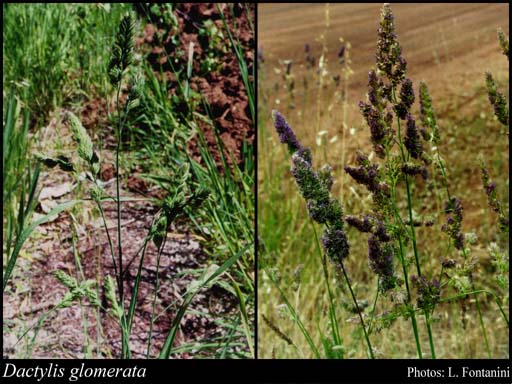- Reference
- Sp.Pl. [Linnaeus] 1:71 (1753)
- Conservation Code
- Not threatened
- Naturalised Status
- Alien to Western Australia
- Name Status
- Current
Tufted perennial, grass-like or herb, 1.4 m high. Fl. purple, Jan to Mar. Sand.







Distribution
- IBRA Regions
- Avon Wheatbelt, Esperance Plains, Jarrah Forest, Swan Coastal Plain, Warren.
- IBRA Subregions
- Dandaragan Plateau, Katanning, Northern Jarrah Forest, Perth, Recherche, Southern Jarrah Forest, Warren.
- IMCRA Regions
- WA South Coast.
- Local Government Areas (LGAs)
- Albany, Armadale, Augusta Margaret River, Busselton, Capel, Dardanup, Denmark, Esperance, Gingin, Manjimup, Nannup, Northam, Plantagenet.
Management Notes (for the Swan NRM Region)
Alternative Names. Cat grass, orchardgrass.
General Biology. Growth form. Grass. Life form. Perennial, caespitose. Reproduction. Seed, tillers. Dispersal. Planting (as fodder), mammals, slashing, occasionally water. Photosynthetic Pathway. C3. Toxicity. Severe allergen. Seedbank persistence. 1-4 years. Fire response. Survives and resprouts after moderate fires. Hot fire will damage root crowns and can kill adult plants.
Notes. Slow to establish and typically needs disturbance to invade natural systems. Once established plants are generally very persistent. Frost, drought and heat resistant. Highly shade tolerant. Can grow on slopes and on shallow dry soils. Dislikes excessive humidity. Thrives on slightly acid to alkaline soils. Germination can occur in either light or darkness, and is largely controlled by moisture availability. Maintains a green basal rosette through winter. Higher nutrient levels make it more competitive over native perennial grasses. Wide range of cultivars available.
Additional information. Origin. Europe, west Asia, North Africa. History of use/introduction. Planted as pasture, used in seed mixtures with other grasses and forbs, revegetation.
Suggested method of management and control. Cut out plants. Slash/burn clumps and spray regrowth with 1% glyphosate. Follow-up with seedling control over following years. Read the manufacturers' labels and material safety data sheets before using herbicides. For further information consult the Australian Pesticides and Veterinary Medicines Authority to determine the status of permits for your situation or state.
Management Calendar
| Calendar Type | Jan | Feb | Mar | Apr | May | Jun | Jul | Aug | Sep | Oct | Nov | Dec | Comments |
|---|---|---|---|---|---|---|---|---|---|---|---|---|---|
| Active Growth | O | O | Y | Y | Y | Y | Y | Y | Summer dormant in dry areas | ||||
| Germination | O | Y | Y | ||||||||||
| Flowering | Y | O | O | O | Y | Y | Y | Y | |||||
| Fruiting | Y | Y | Y | ||||||||||
| Optimum Treatment | Y | Y | Y |
Legend: Y = Yes, regularly, O = Occasionally, U = Uncertain, referred by others but not confirmed.
References
- Baskin, C.C. & Baskin, J.M. (1998) Ecology of seed dormancy and germination in grasses. In Population biology of grasses (ed. G.P. Cheplick) . Cambridge University Press, Cambridge, UK.
- Blood, K. (2001) Environmental weeds: a field guide for SE Australia. C.H. Jerram and Associates, Melbourne.
- Brown, K. & Brooks, K. (2002) Bushland Weeds: A Practical Guide to their Management. Environmental Weeds Action Network, Greenwood.
- Dear, B.S., Sandral, G.A. & Wilson, B.C.D. (2006) Tolerance of perennial pasture grass seedlings to pre- and post-emergence grass herbicides. Australian Journal of Experimental Agriculture, 46: 637-644.
- Groves, R.H., Austin, M.P. & Kaye, P.E. (2003) Competition between Australian native and introduced grasses along a nutrient gradient. Austral Ecology, 28: 491-498.
- Hussey, B.M.J., Keighery, G.J., Dodd, J., Lloyd, S.G. & Cousens, R.D. (2007) Western Weeds. A guide to the weeds of Western Australia. 2nd Edition. The Plant Protection Society of Western Australia, Victoria Park.
- Muyt, A. (2001) Bush invaders of South-East Australia: A guide to the identification and control of environmental weeds found in South-East Australia. R.G. & F.J. Richardson, Melbourne.
- Myers, J.A., Vellend, M., Gardescu, S. & Marks, P.L. (2004) Seed dispersal by white-tailed deer: implications for long-distance dispersal, invasion and migration of plants in eastern North America. Oecologia, 139: 35-44.
- Nie, Z., Clark, S., Stone, L., Virtue, J., Dear, B. & Norton, M. (Undated) Environmental Weed Risk Assessment, Species: Dactylis glomerata. URL: http://www.futurefarmcrc.com.au/documents/D.glomerataweb.doc - Accessed November 2009.
- Norton, M.R., Lelievre, F. & Volaire, F. (2006) Summer dormancy in Dactylis glomerata L.: the influence of season of sowing and a simulated mid-summer storm on two contrasting cultivars. Australian Journal of Agricultural Research, 57: 565-575.
- Pacific Island Ecosystems at Risk (2008) Plant threats to Pacific ecosystems. URL: http://www.hear.org/pier/scinames.htm - Accessed January 2010.
- Peeters, A. (2009) Dactylis glomerata L. Food and Agriculture Organisation of the United Nations URL: http://www.fao.org/ag/AGP/agpc/doc/gbase/DATA/PF000431.HTM - Accessed November 2009.
- Probert, R.J., Smith, R.D. & Birch, P. (1986) Germination responses to light and alternating temperatures in European populations of Dactylis glomerata L.. New Phtyologist, 102 (1): 133-142.
- SDI Health LLC (2009) Dactylis glomerata. URL: http://www.pollenlibrary.com/botany_researchers_maps.php - Accessed November 2009.
- Sullivan, J. (1992) Dactylis glomerata. In U.S. Department of Agriculture, Forest Service, Rocky Mountain Research Station, Fire Sciences Laboratory (2002, April). Fire Effects Information System. URL: http://www.fs.fed.us/database/feis/plants/ - Accessed December 2007.
- Volaire, F. (2003) Seedling survival under drought differs between an annual (Hordeum vulgare) and a perennial grass (Dactylis glomerata). New Phtyologist, 160: 501-510.
- Williamson, J. & Harrison, S. (2002) Biotic and abiotic limits to the spread of exotic revegetation species. Ecological Applications, 12 (1): 40-51.